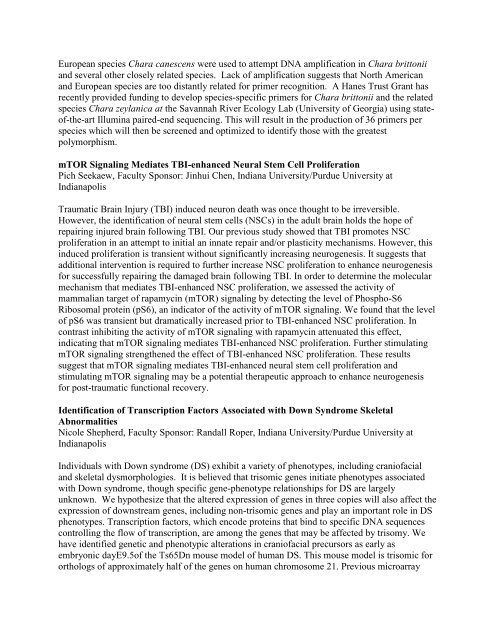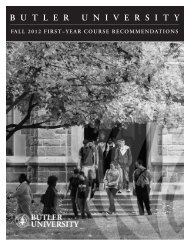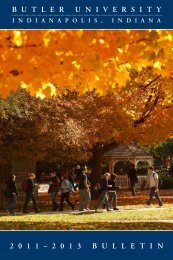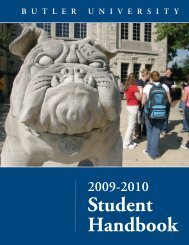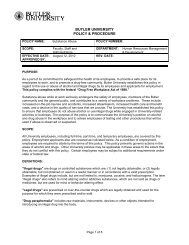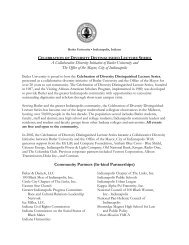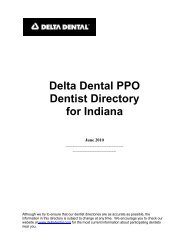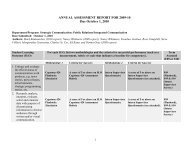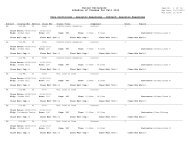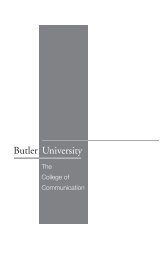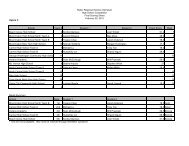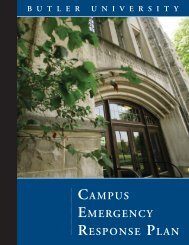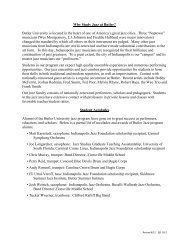Anthropology - Butler University
Anthropology - Butler University
Anthropology - Butler University
You also want an ePaper? Increase the reach of your titles
YUMPU automatically turns print PDFs into web optimized ePapers that Google loves.
European species Chara canescens were used to attempt DNA amplification in Chara brittonii<br />
and several other closely related species. Lack of amplification suggests that North American<br />
and European species are too distantly related for primer recognition. A Hanes Trust Grant has<br />
recently provided funding to develop species-specific primers for Chara brittonii and the related<br />
species Chara zeylanica at the Savannah River Ecology Lab (<strong>University</strong> of Georgia) using stateof-the-art<br />
Illumina paired-end sequencing. This will result in the production of 36 primers per<br />
species which will then be screened and optimized to identify those with the greatest<br />
polymorphism.<br />
mTOR Signaling Mediates TBI-enhanced Neural Stem Cell Proliferation<br />
Pich Seekaew, Faculty Sponsor: Jinhui Chen, Indiana <strong>University</strong>/Purdue <strong>University</strong> at<br />
Indianapolis<br />
Traumatic Brain Injury (TBI) induced neuron death was once thought to be irreversible.<br />
However, the identification of neural stem cells (NSCs) in the adult brain holds the hope of<br />
repairing injured brain following TBI. Our previous study showed that TBI promotes NSC<br />
proliferation in an attempt to initial an innate repair and/or plasticity mechanisms. However, this<br />
induced proliferation is transient without significantly increasing neurogenesis. It suggests that<br />
additional intervention is required to further increase NSC proliferation to enhance neurogenesis<br />
for successfully repairing the damaged brain following TBI. In order to determine the molecular<br />
mechanism that mediates TBI-enhanced NSC proliferation, we assessed the activity of<br />
mammalian target of rapamycin (mTOR) signaling by detecting the level of Phospho-S6<br />
Ribosomal protein (pS6), an indicator of the activity of mTOR signaling. We found that the level<br />
of pS6 was transient but dramatically increased prior to TBI-enhanced NSC proliferation. In<br />
contrast inhibiting the activity of mTOR signaling with rapamycin attenuated this effect,<br />
indicating that mTOR signaling mediates TBI-enhanced NSC proliferation. Further stimulating<br />
mTOR signaling strengthened the effect of TBI-enhanced NSC proliferation. These results<br />
suggest that mTOR signaling mediates TBI-enhanced neural stem cell proliferation and<br />
stimulating mTOR signaling may be a potential therapeutic approach to enhance neurogenesis<br />
for post-traumatic functional recovery.<br />
Identification of Transcription Factors Associated with Down Syndrome Skeletal<br />
Abnormalities<br />
Nicole Shepherd, Faculty Sponsor: Randall Roper, Indiana <strong>University</strong>/Purdue <strong>University</strong> at<br />
Indianapolis<br />
Individuals with Down syndrome (DS) exhibit a variety of phenotypes, including craniofacial<br />
and skeletal dysmorphologies. It is believed that trisomic genes initiate phenotypes associated<br />
with Down syndrome, though specific gene-phenotype relationships for DS are largely<br />
unknown. We hypothesize that the altered expression of genes in three copies will also affect the<br />
expression of downstream genes, including non-trisomic genes and play an important role in DS<br />
phenotypes. Transcription factors, which encode proteins that bind to specific DNA sequences<br />
controlling the flow of transcription, are among the genes that may be affected by trisomy. We<br />
have identified genetic and phenotypic alterations in craniofacial precursors as early as<br />
embryonic dayE9.5of the Ts65Dn mouse model of human DS. This mouse model is trisomic for<br />
orthologs of approximately half of the genes on human chromosome 21. Previous microarray


